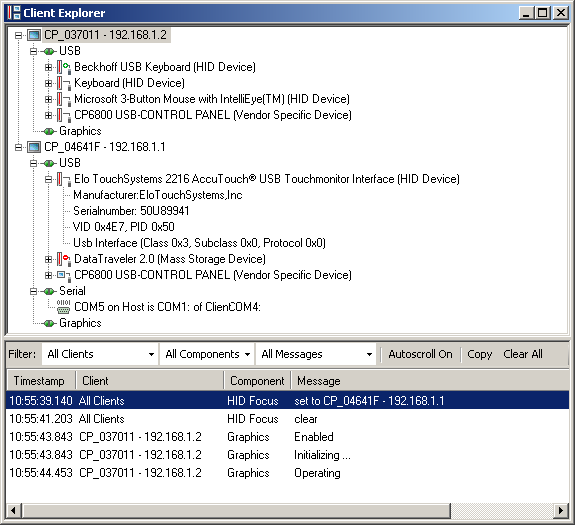Client Explorer
The CP-Link 3 Client Explorer is a tool for monitoring the function of CP-Link 3. Warnings, error messages and status information of the various CP-Link 3 components are shown in Client Explorer.
The Client Explorer user interface is laid out as follows:
The upper section pictures a tree structure, which on one side shows the currently activated CP-Link 3 Configuration and on the other contains current status information. In the lower section is a message window in which warnings, error messages and status information is given in the form of text.
Hierarchy of the tree structure:
Each of the nodes in the first level corresponds to a client:
The nodes in the second level correspond to the CP-Link 3 components "Virtual USB", "Virtual Serial Ports“ and "Virtual Graphics" of the client, where a node is only depicted for those components activated in the configuration. At the same time the icon of such a node gives information on the current status of the component:
Third level nodes contain detailed information on the corresponding component.
Nodes underneath a USB node: Each node represents a USB device which is plugged in at the client. The node text contains product description read from the device (if available) on one side and on the other the device class. The icon of such a node gives information on the current USB device status:
Each USB device node has further sub-nodes which contain detailed information (manufacturer, serial number, etc.) on the USB device.
Right clicking a USB device opens a context menu with which you can add the selected device to one of the USB device filter lists of the configuration (see also the Client Configuration section or the USB Device Filter Lists section):
If you copy the device information into the clipboard (Copy to clipboard) you can paste the copied information in the configuration window in order to create a device filter entry (see also the Client Configuration section - Edit USB device filters).
If the node represents a USB Bus Coupler, one of its sub-nodes indicates the Coupler's device number. Depending on the type of the Bus Coupler, the device number can also be changed. The device number can be changed for all Bus Couplers of the type CPx8xx. Right clicking the device number sub-node opens a context menu with which you can open the dialog for changing the device number.
In the dialog the device number can be edited. The new value is transmitted by clicking the "Change" button. By clicking the "Cancel" button the process can be canceled.
The USB Bus Coupler-Number can alternatively be changed with the TwinCAT System Manager (see also the Using the CPx8xx USB Bus Coupler-Section).
Nodes underneath a serial node: Each node represents a serial interface of the client which can be used on the host PC via "Virtual Serial Ports".
The message window:
In the message window status information and error messages are shown sorted by time. Each entry has a field for the timestamp, a field for the client to whom the message does apply, a field for the component of the corresponding client and a field for the message itself. Error messages are highlighted in red.
Right clicking on the header of the output field opens a menu which is used to choose which components of the messages should be shown or not shown.
Above the output field are several selection boxes which allow different filters to be defined. These filters determine which messages are shown or not shown in the output field. Filtering can be done using any combination of the following criteria:
- ▪
- Filtering on messages of certain clients: Depending on the selection either the messages of all clients (All Clients) or the messages of the clients selected in the tree structure (Only Selected Client) are shown. By default the messages of all clients are shown.
- ▪
- Filtering on messages of certain components: The messages of the selected components are shown. By default the messages of all components are shown.
- ▪
- Filtering on messages of certain type: Depending on selection either all messages (error and info messages) or only error messages are shown. By default all messages are shown.
There are further buttons on the right next to the selection boxes for the message filters:
- ▪
- Autoscroll On/Off - If Autoscroll On is selected and a new entry is inserted into the message window, the contents of the window are scrolled so that the new message appears in the visible part of the message window. If Autoscroll Off is selected, automatic scrolling is turned off, in other words the contents of the window are not scrolled for a new entry.
- ▪
- Copy - All marked messages are copied into the clipboard.
- ▪
- Clear All - All messages are deleted.

















